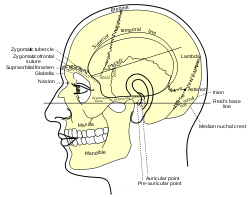| Glabella | |
|---|---|
 Frontal bone, outer surface, (glabella visible near bottom of bone) | |
 Side view of head, showing surface relations of bones (glabella labeled at center left) | |
| Details | |
| Identifiers | |
| Latin | glabella |
| TA98 | A02.1.03.006 |
| TA2 | 525 |
| FMA | 52851 |
| Anatomical terms of bone | |
The glabella, in humans, is the area of skin between the eyebrows and above the nose. The term also refers to the underlying bone that is slightly depressed, and joins the two brow ridges. It is a cephalometric landmark that is just superior to the nasion.[1]
Etymology
[edit]The term for the area is derived from the Latin glaber, meaning 'smooth, hairless'.[2]
In medical science
[edit]The skin of the glabella may be used to measure skin turgor in suspected cases of dehydration by gently pinching and lifting it. When released, the glabella of a dehydrated patient tends to remain extended ("tented"), rather than returning to its normal shape.[3]
See also
[edit]References
[edit]- ^ "Figure 3. Cephalometric landmarks. Glabella (GL), the most prominent or..." ResearchGate. Retrieved 2018-01-23.
- ^ "Definition of Glabella". MedicineNet. Retrieved 2018-01-23.
- ^ Lane., Lilley, Linda (2016-08-05). Pharmacology for Canadian health care practice. Lilley, Linda Lane, Snyder, Julie S., Swart, Beth, 1948-, Collins, Shelly Rainforth., Savoca, Diane. (Third Canadian ed.). Toronto. p. 590. ISBN 9781771720663. OCLC 981956602.
{{cite book}}: CS1 maint: location missing publisher (link) CS1 maint: multiple names: authors list (link)
External links
[edit] Media related to Glabella (anatomy) at Wikimedia Commons
Media related to Glabella (anatomy) at Wikimedia Commons
Well, that’s interesting to know that Psilotum nudum are known as whisk ferns. Psilotum nudum is the commoner species of the two. While the P. flaccidum is a rare species and is found in the tropical islands. Both the species are usually epiphytic in habit and grow upon tree ferns. These species may also be terrestrial and grow in humus or in the crevices of the rocks.
View the detailed Guide of Psilotum nudum: Detailed Study Of Psilotum Nudum (Whisk Fern), Classification, Anatomy, Reproduction